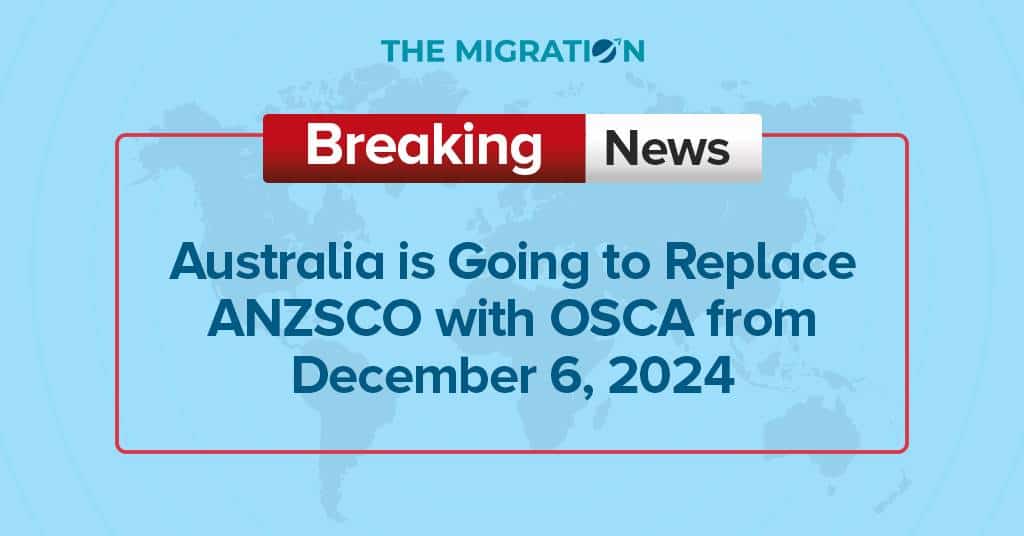Australia is going to replace the Australian and New Zealand Standard Classification of Occupations (ANZSCO) with the new Occupation Standard Classification for Australia (OSCA). This transition is significant for skilled individuals, employers, industries, and migration professionals. Both countries will introduce their own customised occupational statistical classifications.
Australia will release its new Occupation Standard Classification for Australia (OSCA) on Friday, 6 December 2024.
The transformation from ANZSCO to OSCA is based on the evolving needs of the Australian labour market. To learn more about what OSCA is, how it varies from ANZSCO, and its implications for skilled migration and employment in Australia, continue reading this blog.
Let’s first understand what an ANZSCO is.
What is ANZSCO?
ANZSCO refers to the Australian and New Zealand Standard Classification of Occupations. It is used to classify and describe occupations in the Australian and New Zealand labour markets. It organises jobs with similar tasks and responsibilities into categories and each occupation is assigned a unique six-digit code.
In general, candidates seeking skilled visas are required to select a profession from the ANZSCO list that aligns with their training and work history. Basically, this system helps the Department of Home Affairs assess whether an applicant is qualified to fill skills gaps in the Australian labour market or not.
What is OSCA?
OSCA refers to Occupation Standard Classification for Australia. It is a new framework for classifying different occupations according to the current and future needs of the Australian labour market.
OSCA aims to offer a more comprehensive, updated, and flexible classification of occupations. It is designed to improve accuracy and usability for employers, industries, and government bodies.
So, what are the main differences between ANZSCO and OSCA?
What is the Difference between ANZSCO and OSCA?
The main difference between these two classification systems is that ANZCO deals with both New Zealand and Australian labour markets, while OSCA is designed only for the Australian workforce industry. To learn more about the differences between ANZSCO and OSCA, look at the table below:
| Feature | ANZSCO | OSCA |
| Development | Joint system for Australia and New Zealand, established in 2006. | Australia-specific classification system will be released on December 6,2024. |
| Focus | Cover both Australian and New Zealand labour markets. | Designed specifically to the Australian labour market requirements. |
| Flexibility | Less adaptive to rapid changes in the workforce. | More adaptive and flexible. |
| Occupation Classifications | May include outdated roles. | Updated classifications that align closely with modern labour demands. |
| Skill Level Definitions | Skill levels defined but may lack clarity in categorization. | Refined skill level definitions. |
| Support for Emerging Roles | Limited support for rapidly growing industries. | Designed to accommodate new and emerging occupations. |
Change from ANZSCO to OSCA: Drivers for Change
The decision by the government statisticians to update the classification system for occupations in Australia and New Zealand was made after years of discussion. Here are the drivers behind this transition:
Labor Market Differences
The labour markets in Australia and New Zealand have become more different since the establishment of ANZSCO in 2006. Initially, all occupations had the same skill levels in both countries. Now, 56 out of 1,076 occupations have different skill levels between Australia and New Zealand.
Limited Participation of NZ
New Zealand’s statistics agency has been unable to take part in the targeted updates that occurred in 2021 and 2022. Moreover, they didn’t participate in the ABS’s comprehensive review of the classification during the last four years. Therefore, the Australian Government is going to launch its own classification system on December 6, 2024.
Flexible Classification to Meet Industry Needs
Both the Australian Bureau of Statistics (ABS) and the New Zealand Statistics Agency have recognised that they need different approaches to meet the needs of their stakeholders. The purpose of this transition is to create a more relevant and accurate classification system that targets each country’s specific labour market conditions.
How Will the ANZSCO to OSCA Transition Impact Skilled Migrants and Employers?
The shift to OSCA is expected to have significant benefits for skilled migration processes in Australia.
- Skilled migrants will be able to easily deal with the visa application process because of clearer occupation classifications. The system focuses on the latest market demands and is flexible enough to make required changes.
- Employers will benefit from a more precise classification system that aligns with their specific needs. The system will facilitate better recruitment strategies.
- OSCA’s design allows for regular updates, ensuring that it remains relevant in a rapidly changing economic landscape.
What will be the Impact on Other Joint Classifications?
The future of comparable but similar industry classifications for both countries, such as Australian and New Zealand Standard Industrial Classification (ANZSIC), is currently being considered.
The current setup for two more joint classifications has not changed.
- Australian and New Zealand Standard Offence Classification (ANZSOC)
- Australian and New Zealand Standard Research Classification (ANZSRC)
Final Thoughts
The transition from ANZSCO to OSCA is going to launch on December 6, 2024. This step shows a significant step in Australia’s approach to occupational classification. This motive aims to facilitate the immigration process by aligning it with labour market needs. It is important for all the stakeholders—including employers, skilled migrants, and migration professionals—to stay updated with the latest information.
I, Samavia Shahid, am a researcher and content writer at The Migration. I create easy-to-understand and informative content for people who want to move to Australia. My goal is to make the migration process simpler and less stressful for everyone.











